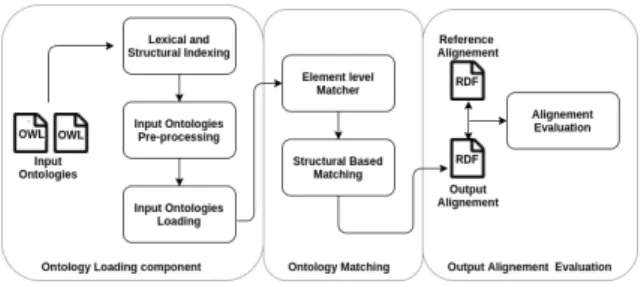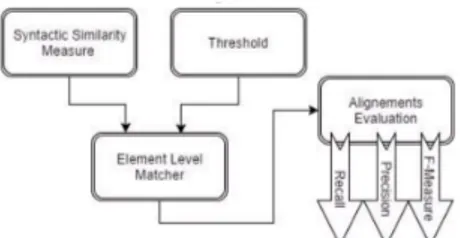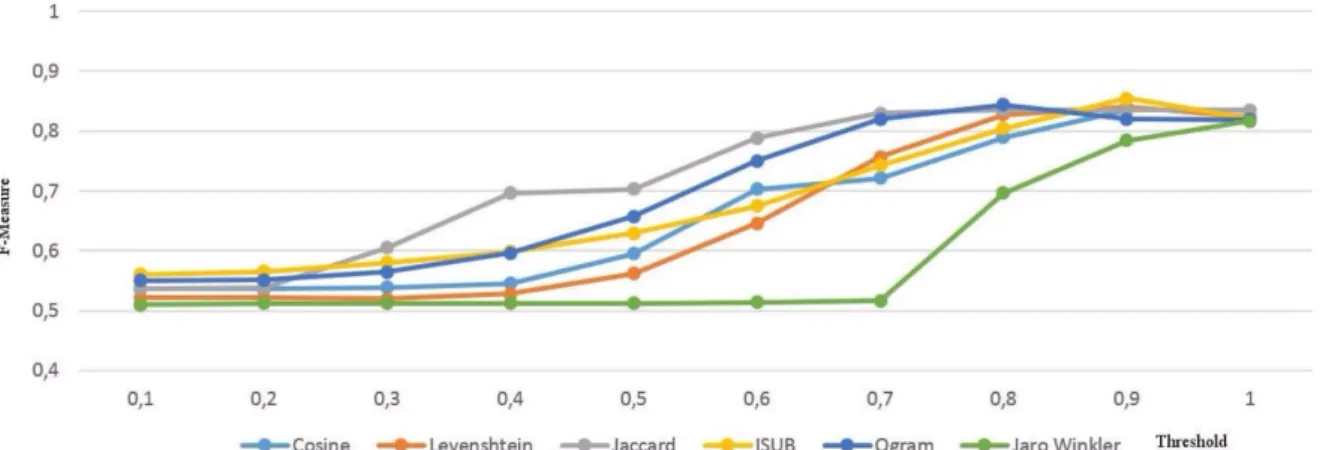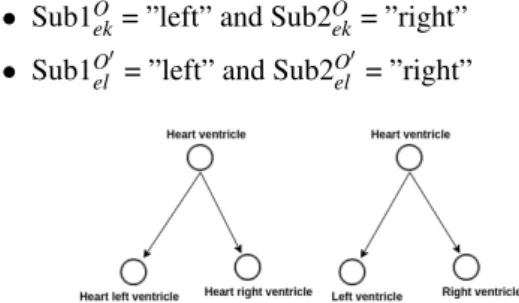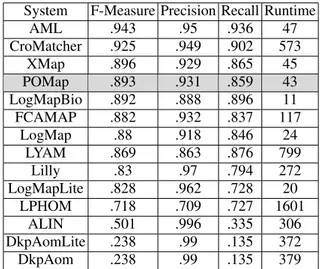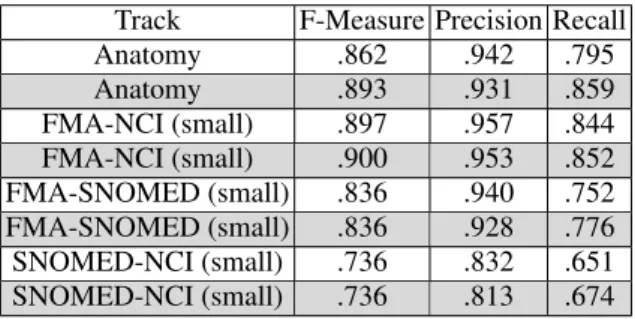OATAO is an open access repository that collects the work of Toulouse
researchers and makes it freely available over the web where possible
Any correspondence concerning this service should be sent
to the repository administrator:
tech-oatao@listes-diff.inp-toulouse.fr
This is an author’s version published in:
https://oatao.univ-toulouse.fr/22110
To cite this version:
Laadhar, Amir and Ghozzi, Faiza and Megdiche Bousarsar, Imen
and Ravat, Franck and Teste, Olivier and Gargouri, Faiez POMap:
An Effective Pairwise Ontology Matching System. (2017) In: IC3K
2017 : 9th International Joint Conference on Knowledge Discovery,
Knowledge Engineering and Knowledge Management, 1 November
2017 - 3 November 2017 (Funchal, Portugal).
Open Archive Toulouse Archive Ouverte
Official URL :
POMap: An Effective Pairwise Ontology Matching System
A. Laadhar
1, F. Ghozzi
2, I. Megdiche
1, F. Ravat
1, O. Teste
1and F. Gargouri
2 1University of Toulouse, IRIT (CNRS/UMR 5505), 118 Route de Narbonne, 31062 Toulouse, France2University of Sfax, MIRACL, Sakiet Ezzit 3021, Tunisia
Keywords: Semantic Web, Ontology Matching System, Syntactic Matching, Structural Matching.
Abstract: The identification of alignments between heterogeneous ontologies is one of the main research issues in the semantic web. The manual matching of the ontologies is a complex, time consuming and an error prone task. Therefore, ontology matching systems aims to automate this process. Usually, these systems perform the matching process by combining element and structural level matchers. Selecting the optimal string similarity measure associated with its threshold is an important issue in order to enhance the effectiveness of the element level matcher, which in turn will improve the whole ontology system results. In this paper, we present POMap, an ontology matching system based on a syntactic study covering element and structural levels. For the element level matcher we have adopted the best configuration based on the analysis of the performances of many string similarity measures associated with their thresholds. For the structural level, we have performed a syntactic study on both subclasses and siblings in order to infer the structural similarity. Our proposed matching system is validated and evaluated on the Anatomy, the Conference and the Large Biomedical tracks provided by the benchmark of OAEI 2016 ontology matching campaign.
1 INTRODUCTION
To ensure the interoperability between different plat-forms, ontologies has been used as the essence of the semantic web. An ontology can model a particular domain as well as the relationships between its enti-ties in order to allow data to be shared, reused, inte-grated and queried by different stakeholders. Ontol-ogy matching is the process of finding a set of map-pings between the entities of two or more ontologies representing a similar domain (Shvaiko and Euzenat, 2013). Therefore, the ontology matching community has been proposing a variety of strategies in order to automate the ontology matching process.The ontol-ogy matching process takes as an input two ontolo-gies, which contain a set of entities. Usually the map-pings between two entities is evaluated by a score of similarity ∈ [0,1]. This score defines the degree of confidence of a mapping relationship. This confi-dence value is configured automatically by the match-ing system. A matcher is an algorithm that processes two ontologies and returns the set of mappings be-tween them along with a similarity value. Usually, a matching system combines several distinct match-ers depending on the input ontologies characteristics. This combination aims to improve the final
align-ment effectiveness. A single matcher is not sufficient to achieve a high-quality alignments results. Match-ers are classified into two main levels: element level matchers and structure level matchers (Shvaiko and Euzenat, 2013). Each level can rely on different tech-niques and methodologies such as syntactic, semantic and structural based matching.
In this paper, we address the problematic of on-tology matching while focusing on the syntactic char-acteristics of both element level and structural level. As a first step, we focus on finding the optimal sim-ilarity measure and threshold in order to perform the element level matching process. The two target on-tologies are matched using the element matcher while exploring all the names of an ontology class, such as labels, local name and synonyms. We performed a series of tests in order to define the optimal similar-ity measure and threshold. Since we are adopting a sequential composition, the output of element level matcher is the input of the structural based matcher. Dealing with the structural matching, Almost the ex-isting research works focus on the propagation of the syntactic similarity score in order to derive new struc-tural mappings. However, this propagation do not take into consideration the syntactic characteristics of the target entities. Therefore, we propose two
tural matchers, guided by the syntactic treatments on the subclasses and the sibling entities without mea-suring any structural similarity score. Each structural matcher focuses on a part of the ontology hierarchy in order to obtain a new set of alignments. These match-ers take profit of the hierarchical relationships of an ontology siblings and subclasses exploiting by a syn-tactic treatments of common words.
The remainder of this paper is organized as fol-lows: Section 2 discusses the existing ontology matching systems. Section 3 presents the POMap ontology system including the element and structural level matchers. Section 4 evaluates and discusses the obtained results. Conclusion and suggestions for fu-ture work are shown in section 5.
2 RELATED WORKS
Matching Levels. Usually, a matching system em-ploys different matchers which in turn follow dis-tinct matching techniques (Otero-Cerdeira et al., 2015)(Megdiche et al., 2016).
The element level matchers determine the map-pings between two entities without taking into con-sideration the existing relationships between these en-tities. The state of the art element level matchers are mostly relying on string based techniques, which compute the similarity between two entities through syntactic similarity measures. Language-based tech-niques can also be employed by the element level matchers. These techniques rely on natural language processing (NLP) such as the stop words removal and lemmatisation in order to derive meaningful terms. Constraint based techniques can be also employed in order to analyse the internal structure of an entity like the domain, range as well as the cardinality of the at-tributes.
Structure level matchers can use external knowl-edge while taking profit of the relationships between the entities (classes, instances and properties). Re-searchers have been employing several techniques such as graph-based and instance based. The graph based techniques compute structural similarities be-tween neighbouring entities based on their position in the ontology. Following this intuition, Similarity Flooding (SF) (Melnik et al., 2002) is a well-known structural matcher inspired by the idea of structural similarity propagation. This technique propagates the structural similarity score among the ontology candi-date mappings. In another research work, (Cruz and Sunna, 2008) proposed two structural matchers: De-scendants Similarity Inheritance (DSI) and Siblings Similarity Contribution (SSC). For a given set of
ini-tial mappings discovered by an element level matcher, the main idea of DSI and SSC is to refine the initial element level mappings with weighted scores accord-ing to the descendants and the siblaccord-ings. DSI slightly outperform the Similarity Flooding method. How-ever, even after applying these structural matchers, the value of F-measure still not good enough in terms of effectiveness. We argue that this inefficiency is caused by the bad quality of the initial alignments re-sulted our first matcher. In this research work, dif-ferentiated from the state of the art, we do not mea-sure any structural similarity score. Therefore, we are guided by the initial similarity score in order to de-rive new structural mappings while taking the rela-tionships between the entities as a discriminating fea-ture. These initial mappings are the input of the struc-tural level matcher in order to deduce a new set of mappings.
Ontology Matching Systems. We review some of the top relevant and mature matching systems, which had a significant success during the last years of the OAEI campaign. Our results will be compared with these matching systems on section 4.
Agreement Maker Light (AML) (Faria et al., 2013) is an automated large-scale ontology matching system focusing on the biomedical ontologies match-ing. AML translates the entities of the input ontolo-gies into the same language. Then, AML employs several matchers such as a lexical matcher, an external background knowledge matcher, a structural matcher and an instance matcher. AML follows a sequential composition. The first matcher implemented by AML is the Lexicon Matcher, which searches for exact matching between the entities names of the two input ontologies. AML employs also a mediating matcher, which take profit of some external knowledge sources in order to enrich the input ontologies by new tex-tual content. In the OAEI 2016 compaign, AML used the following external knowledge resources: Uber Anatomy Ontology (Uberon) (Mungall et al., 2012), the Human Disease Ontology (DOID) (Schriml et al., 2011), the Medical Subject Headings (MeSH) (Nel-son et al., 2001) and Wordnet (Miller, 1995). AML derives its structural matcher from the DSI algorithm. LogMap (Jim´enez-Ruiz and Grau, 2011) is an on-tology matching system focusing on both the ele-ment level and the structural level matching of large biomedical ontologies. The architecture of LogMap is divided into two main stages: the computation of candidate mappings and their assessment. In the first stage, LogMap extracts a set of initial candidate map-pings using a lexical comparison method. These can-didate mappings are extracted from the inverted index of each input ontology. An inverted index contains
the labels and the URIs of each ontology. In the sec-ond stage, LogMap tries to remove the set of incor-rect candidate mappings by applying lexical, struc-tural and reasoning techniques.
XMap (Djeddi and Khadir, 2014) deals especially with the problem of scalability. XMap follows a sequential composition of three layers: terminolog-ical Layer, structural layer and alignment layer. In the terminological layer, XMap employs a transla-tion matcher in case of multilingual ontologies. Also, XMap uses a string matcher, which computes the sim-ilarity between the textual descriptions of two en-tities by applying some semantic measures. Xmap employs two background knowledge sources word-net (Miller, 1995) and UMLS (Bodenreider, 2004)). During the structural layer, XMap computes the sim-ilarity between two entities by taking into account the internal structure of a concept. Finally, in the alignment Layer, the set similarity scores resulted by the string matcher, the linguistic matcher and the structural-based matcher are aggregated using mathe-matical methods.
CroMatcher (Guli´c et al., 2016) is an ontology machting system concentrating on the aggregation of different matchers using a weighted factor. Cro-Matcher divides its matchers into two main sets: string based and structure based. The string based matchers determines the mappings between two en-tities relying on several techniques such as syntac-tic similarity measure, instance matching and prop-erty matching. CroMatcher performs the structural matching using four distinct matchers: Super En-tity matcher, sub enEn-tity matcher, domain matcher and range matcher. The matching system aggregates the results of the string matchers and the structural match-ers by automatically giving a weight for each sin-gle matcher. The two obtained matrices of the string based matcher and structural based matcher are also combined using an automated weighting factor in or-der to obtain the final set of alignments.
3 THE POMAP ONTOLOGY
MATCHING SYSTEM
3.1 POMap Matching System Overview
The workflow of POMap is depicted in Figure 1. This workflow contains several steps beginning by the OWL ontologies loading until the RDF output align-ment evaluation. The architecture of POMap contains three main components: The ontology loading, the ontology matching and the output alignment
evalua-tion. We will describe in the following sub-sections the set of activities performed by each component.
Figure 1: The architecture of POMap.
3.2 Ontology Loading Component
We parse a given set of two input ontologies using OWL API in order to populate our lexical and struc-tural data structure. The lexical data structure is a multimap that contains the triplet: a set of classes, their names as well as the type of each names. A name has one of these types: URIs, labels or syn-onym properties. In terms of the structural data struc-ture, we store all the relationships between classes. A pre-processing techniques are mandatory to acquire a cleaner data-set. Since several similarity measures take into consideration the letter case as a parame-ter influencing the similarity score, we set in lower-case all the input ontology names. Next, we discard all stopwords as well as the non-alphanumeric char-acters. We also replace every underscore to a space character. Finally, we perform an English stemming process as the one proposed by Porter (Porter, 2001).
3.3 Element Level Matcher
In order to discover mappings, ontology match-ing systems employ one or more similarity mea-sures without any reference to the defined thresholds. Therefore, we tested the different similarity measures in order to define the optimal measure and threshold after performing the pre-processing steps. After the pre-processing steps, the input ontologies are quite ready to be processed by our element level matcher. This matcher is responsible for computing the simi-larity score between all the class names of the first and the second ontology. To perform that, we fol-low an all-against-all strategy, which stands for mea-suring the similarity score between all the the pos-sible combinations of the entities of the two ontolo-gies. Then, we choose the maximum similarity score for every pair of resulted candidate mappings. We argue that comparing all the names of the two in-put ontologies is more efficient than comparing only the labels. For instance, our element level matcher
achieved an F-Measure of 0.830 using only the la-bels on the anatomy OAEI dataset. However, using all the names associated with the Anatomy entities, we succeeded to accomplish an F-Measure of 0.862. Therefore, we are able to better capture the syntactic mappings between two ontologies and achieve better results. We employed similarity measures in order to compare pairwise names. The efficiency of a syntac-tic matcher is determined by the trade-off between its resulted F-measure value and its runtime. For exam-ple, a non-efficient syntactic matcher can produce a high F-measure in a very long time. The variety of syntactic similarity measures arises the difficulty of choosing the optimal one associated with its thresh-old. The optimal choice of the similarity measure and threshold will immediately improve the alignment sults especially in terms of F-measure. Some re-searchers (Duan et al., 2010) (Cheatham and Hitzler, 2013) (Ngo et al., 2013) (Sun et al., 2015) analysed the performance of similarity measures while dealing with the ontology matching process. However, none of them analysed the performance of these measures after performing the pre-processing based on all the names of an ontology class. Moreover, almost of re-searchers did not included ISUB (Stoilos et al., 2005) in their comparison. Consequently, we will reveal the best similarity measure in terms of F-measure, thresh-old and runtime. In order to select the optimal F-Measure, we apply a trimming process using a differ-ent threshold value for each syntactic similarity mea-sure. As shown in figure 2, for every experiment, the element level matcher has as an input a single mea-sure associated with a threshold value. The output of the testing process are the set of evaluation criteria: the recall, the precision and the F-Measure. During our series of tests, we vary the threshold value from the range of 0.1 to 1 with an interval of 0.01.
Figure 2: The input/output schema of the element level test-ing process.
Then, we compute the F-measure for each thresh-old interval. The employed tracks in our testing pro-cess are: the Anatomy track and the Large Biomed-ical track. For the later, we evaluated the avail-able similarity measures used by our element level matcher through the three small fragments: FMA-NCI , SNOMED-FMA and SNOMED-FMA-NCI. Figure 3
draws the variation of F-Measure while adopting dif-ferent thresholds in the Anatomy track of OAEI. Fig-ure 4, FigFig-ure 5, FigFig-ure 6 and FigFig-ure 7 show the value of the optimal F-measure and threshold obtained by each similarity measure for each OAEI track. The other tested state of the art syntactic similarity mea-sures are available at: https://goo.gl/1kUgkH. On all the three tasks, ISUB with a threshold of 0.9 outper-form the other similarity measures. We conclude that ISUB 0.9 is the best measure for ontologies syntactic matching associated with the pre-processing steps. To optimise the execution time we took profit of the multi core architecture of the processor. Therefore, we adopted an intra-matching parallelism methodology. Thus, the element level matcher is divided into the number of available CPU cores and executed in paral-lel. For a given two input ontologies, the algorithm of the element level matcher loops classes names of the source and target indexes and derives for each class index the set of corresponding names. These names are compared to each other using a syntactic simi-larity measure (ISUB). Only the pair of names hav-ing a threshold above the 0.9 are added to the set of mappings. Since we are pursuing an alignment multi-plicity of 1:1, we followed the element level matcher by a cleaning process of the resulted candidate map-pings. Therefore, we keep only the maximum similar-ity score that a single class can have. If two mappings have the same similarity score we select randomly one of them.
3.4 Structural Level Matching
For a given set of alignments, which are discovered by the element level matcher, we can enrich these mappings by a set of new ones by applying the struc-tural matching. Our strucstruc-tural level matcher is com-posed of two structural sub-matchers: siblings and subclasses. During the first sub-matcher, we follow the intuition that states: if two classes are similar, then their siblings should be somehow similar (Shvaiko and Euzenat, 2013). In the second sub-matcher, we remove the common words between the super class and its subclasses. Moreover, this matcher admit the idea that: if two classes are similar, then their sub-classes should be also similar. In that way, the struc-tural matching improves the initial matching results of the element level matcher.
3.4.1 Structural Matcher based on Siblings This structural matcher detects new mapping based on the siblings of the already discovered alignments by the element level matcher. These mappings have a similarity score between ISUB 0.9 and ISUB 0.8.
Figure 3: The variation of F-Measure over the Anatomy track while adapting different similarity measure and thresholds.
Figure 4: Top F-Measure in Anatomy task.
Figure 5: Top F-Measure in FMA-NCI small fragment.
Figure 6: Top F-Measure in FMA-SNOMED small frag-ment.
We argue that if two entities are matching, then their siblings will probably match. Therefore, we decrease the threshold from 0.9 to 0.8. For a given ontology O
and an entity eO, the jthsibling of an entity e is
de-noted as SibjO
e, where∑ SibjOe ∈ [0,m] and m is the
Figure 7: Top F-Measure in SNOMED-NCI small frag-ment.
number of siblings. We consider a single mapping re-sulted by the element level matcher as: ai= (eOk ,eOL0,s)
with Sib1O
ekis the only sibling of eOl . If the
similar-ity score between the two siblings is high (still below the syntactic threshold), then we consider that the two siblings will certainly match. However, if the two en-tities eO
K and eOL0 have many siblings, then we should
compare all the siblings of eO
k with the siblings of eOl0.
Therefore, we perform an all-against-all comparison
between all the siblings of eO
k and eOl0. Next, like the
element level matcher, we pursue an alignment mul-tiplicity of 1:1. The input of the sibling matching al-gorithm is the discovered mappings by the syntactic matcher as well as the two input ontologies. The out-put of this matcher is the new set of structural map-pings, which are added to the initial mappings dis-covered by the element level matcher. Since we used a threshold of 0.8 ISUB for the structural matcher, we removed all the mappings, which are already discov-ered by the syntactic matcher.
3.4.2 Structural Matcher based on Subclasses For the subclasses structural matcher, we are follow-ing the intuition that if two classes are similar, then their sub classes are similar (Shvaiko and Euzenat, 2013). Given an ontology O and an entity e of O,
the jthdescendant of eOis denoted as SubjO
e, where∑
SubO
e ∈ [0,n] and n is the number of descendants. To
illustrate, if a single mapping is denoted as ai= ( eOk,
eO0
L , s), SubjOekis the descendent of eOk and SubjOel0 is
the descendent of eO0
l . Therefore, SubjOel0 and SubjOek
are probably similar. However, if there are many
sub-classes of eO
k and eOl0, it will be complex to perform
the mapping process between the descendant, espe-cially when they have close similarity scores. There-fore, it is necessary to find some other discriminating features (Shvaiko and Euzenat, 2013). To illustrate, we consider an example of mapping resulted from the element level matcher: ai= ( eOk, eOl0 , s), with s >
threshold and the name of eO
k = eOl0 = ”heart ventrice”.
For simplicity, as shown in the figure 8, each entity of this mapping has only two subclasses:
• Sub1Oek, Sub2Oekwhere the name of Sub1Oek= heart
left ventricle and the name of Sub2O
ek = ”heart
right ventricle”.
• Sub1Oel0 , Sub2Oel0 , where the name of Sub1Oel0 =
”left ventricle” and the name of Sub1O0
el= ”right
ventricle”
Then, we remove the common tokens between the
entity ekO and its descendants (Sub1ekO , Sub2ekO ).
We also remove the common tokens between elO0 and
its descendants (Sub1elO0 , Sub2elO0) . Consequently,
the descendants (sub-classes) became:
• Sub1Oek= ”left” and Sub2Oek= ”right”
• Sub1Oel0= ”left” and Sub2Oel0 = ”right”
Figure 8: Structural matching based on subclasses illustrat-ing example.
As a result, we can match the descendants of
ekO ( Sub1Oek , Sub2Oek ) and the descendants of
eO0l (Sub1O0el , Sub2O0el) by computing the similarity
score between them (all-against-all strategy). Since we are following a 1:1 multiplicity, then we keep only the maximum score for each class of the candi-date structural mappings, which has a similarity score above the threshold (Monge Elkan 0.85). Unlike ISUB, Monge Elkan (Monge et al., 1996) is able to capture the mappings between two textual sequences, which are containing numerical values. Furthermore, Monge Elkan is not recommended for large matching tasks, as a result we are using it only for the structural
matching process. The new discovered mappings are added to the list of initial alignments which are identi-fied by the element level matcher. The mappings data structure contains the list of the already discovered mappings from the two input ontologies. We notice that we pursued a cleaning process of the discovered mappings by the structural matcher in order to dis-card the list of mappings already found by the element level matcher as well as structural matcher based on siblings.
4 EXPERIMENTS AND
DISCUSSIONS
4.1 Experimental Setup
We developed the POMap system using JAVA and Eclipse as the integrated development environment. We choose to perform the experiment process analy-sis through two biomedical tracks of the OAEI bench-mark as well as the conference track in order to show the efficiency of POMap in various matching tasks while dealing with OWL ontologies. We employed for our series of tests a hardware configuration of: 15Gb of RAM coupled with an Intel Core i5-4570 CPU @3.40 Ghz x 4. This configuration is similar to the one used by the OAEI benchmark. We com-pare the performance of POMap with the results of ontology matching system enrolled in the OAEI 2016 campaign obtained using the Anatomy, Conference as well as the LargeBio track.
4.2 Experimental Results
Anatomy. The anatomy track is a matching task between the Adult Mouse Anatomy (2744 classes) and the NCI Thesaurus (3304 classes) describing the human anatomy. In terms of F-Measure, POMap is ranked in the fourth position among 14 match-ing systems while producmatch-ing a competitive runtime of 43 seconds. We achieved an F-Measure of 0.893 without using any external knowledge source unlike the other top performing matching systems (AML, LogMap and XMap). Table 1 illustrates the position-ing of POMap (grey color) compared to the partici-pated matching systems of OAEI 2016.
Conference. This track consists of matching seven ontologies describing the conference organisation do-main. Dealing with the conference dataset, we suc-ceeded to achieve an F-Measure of 64%, which is an average score compared to the other matching sys-tems. Since this dataset includes the matching of
Table 1: POMap results in the anatomy track compared to the OAEI 2016 systems.
System F-Measure Precision Recall Runtime
AML .943 .95 .936 47 CroMatcher .925 .949 .902 573 XMap .896 .929 .865 45 POMap .893 .931 .859 43 LogMapBio .892 .888 .896 11 FCAMAP .882 .932 .837 117 LogMap .88 .918 .846 24 LYAM .869 .863 .876 799 Lilly .83 .97 .794 272 LogMapLite .828 .962 .728 20 LPHOM .718 .709 .727 1601 ALIN .501 .996 .335 306 DkpAomLite .238 .99 .135 372 DkpAom .238 .99 .135 379
properties, we plan to add the data property and ob-ject property matchers in our next version of POMap. Large Biomedical Ontologies. The large Biomedical Ontologies track aim to find the alignments between three large ontologies: The Foundational Model of Anatomy (FMA), SNOMED Clinical Terms and the National Cancer Institute Thesaurus (NCI). Table 2 represents the obtained results for the FMA-NCI small fragment. We succeed to achieve an F-measure of 90%. Table 3 illustrates the results of POMap for the FMA-SNOMED small fragment in which we ob-tained an F-measure of 84% better than two matures matching systems. We draws in the table 4 the results of POMap in the SNOMED-NCI small fragment task in which we achieved an F-measure of 73%. All the resulted alignments by our system can be downloaded at https://goo.gl/gRYtQj.
After performing the experimental process, we can notice that some matching systems (AML, LogMap, XMAP and Cromatcher) are performing better than POMap. We argue that these systems are outperforming POMap because of their implementa-tion of a variety of matchers. However, POMap im-plements only three matchers: one syntactic matcher and two structural matchers. For instance, XMap em-ploys different matchers such as a translation matcher and a semantic matcher, which uses external back-ground knowledge sources. However, POMap do not perform any semantic matching process. Compared to the runtime of other matching systems, we mention that our element level matcher is the responsible of an exponential growth of the execution time. However, even with these drawbacks, we are able to accom-plish acceptable results due to the efficiency of our syntactic matcher resulted by a study of the different similarity measures. Compared to the top
perform-Table 2: POMap results in the FMA-NCI small fragment compared to the OAEI 2016 matching systems .
System F-Measure Precision Recall Runtime
XMAP .937 .977 .901 17 FCA MAP .935 .954 .917 236 AML .931 .963 .902 35 LogMap .924 .949 .901 10 LogMapBio .923 .935 .910 1712 POMap .900 .953 .852 241 LogMapLite .887 .967 .819 1 LYAM .796 .721 .889 1043 Lilly .657 .603 .721 699 ALIN .625 .995 .455 5811 DkpAom-Lite .615 .652 .577 1698 DkpAom .616 .652 .577 1547
Table 3: POMap results in the FMA-SNOMED small frag-ment compared to the OAEI 2016 matching systems.
System F-Measure Precision Recall Runtime
XMAP .912 .989 .846 54 FCAMAP .865 .936 .803 1865 POMap .846 .928 .776 1223 AML .825 .953 .727 98 LogMapBio .801 .944 .696 1180 LOGMAP .799 .948 .690 60 LogMap .343 .968 .209 2
Table 4: POMap results in the SNOMED-NCI small frag-ment compared to the OAEI 2016 matching systems .
System F-Measure Precision Recall Runtime
AML .797 .904 .713 537 LogMap .771 .922 .663 117 LogMapBio .770 .896 .675 3757 POMap .736 .813 .674 6920 XMap .697 .911 .564 .697 LOGMAPLite .693 .892 .567 693
ing systems of OAEI 2016, which are proposing sev-eral matchers, POMap produces competitive results using efficient matchers without relying on any exter-nal knowledge resources. In order to have a better in-sight of the efficiency of the structural matching step, the following table 5 draws the results before and after performing the structural matching process. The grey color highlights the use of the structural matching.
5 CONCLUSION
In this paper, we described POMap a novel matching system dedicated for the ontologies matching process. POMap is employing syntactic techniques in order to accomplish the element and structural level matching.
Table 5: POMap results before and after (grey color) using the structural matching.
Track F-Measure Precision Recall
Anatomy .862 .942 .795 Anatomy .893 .931 .859 FMA-NCI (small) .897 .957 .844 FMA-NCI (small) .900 .953 .852 FMA-SNOMED (small) .836 .940 .752 FMA-SNOMED (small) .836 .928 .776 SNOMED-NCI (small) .736 .832 .651 SNOMED-NCI (small) .736 .813 .674
After performing a series of experiments, we provided the top performing similarity measures and thresholds that can be employed by an element level matcher in the case of pre-processed ontologies. We have proposed two structural matchers, which perform the syntactic treatment over the siblings as well as the sub classes. These two structural matchers explore the ini-tial mappings resulted by the element level matcher in order to improve the matching system results.
As a future work, we plan to adapt our matching system in order to achieve a better run time over the larger datasets of the OAEI campaign. While dealing with other ontology matching fields rather than the biomedical domain, other syntactic similarity mea-sure can outperform the ones that we recommended. Thus, we will concentrate on automating the process of finding the best similarity measure and threshold depending on the ontology matching context. There-fore, we target the prediction of the optimal similar-ity measure associated with its threshold by extracting various features related to an ontology matching task.
REFERENCES
Bodenreider, O. (2004). The unified medical language sys-tem (umls): integrating biomedical terminology. Nu-cleic acids research, 32(suppl 1).
Cheatham, M. and Hitzler, P. (2013). String similarity met-rics for ontology alignment. In International Semantic Web Conference. Springer.
Cruz, I. F. and Sunna, W. (2008). Structural alignment methods with applications to geospatial ontologies. Transactions in GIS, 12(6).
Djeddi, W. E. and Khadir, M. T. (2014). A novel approach using context-based measure for matching large scale ontologies. In International Conference on Data Warehousing and Knowledge Discovery. Springer. Duan, S., Fokoue, A., and Srinivas, K. (2010). One size
does not fit all: Customizing ontology alignment using user feedback. The Semantic Web–ISWC 2010. Faria, D., Pesquita, C., Santos, E., Palmonari, M., Cruz,
I. F., and Couto, F. M. (2013). The agreementmak-erlight ontology matching system. In OTM
Confed-erated International Conferences” On the Move to Meaningful Internet Systems”. Springer.
Guli´c, M., Vrdoljak, B., and Banek, M. (2016). Cro-matcher: An ontology matching system based on automated weighted aggregation and iterative final alignment. Web Semantics: Science, Services and Agents on the World Wide Web, 41.
Jim´enez-Ruiz, E. and Grau, B. C. (2011). Logmap: Logic-based and scalable ontology matching. In Interna-tional Semantic Web Conference. Springer.
Megdiche, I., Teste, O., and Trojahn, C. (2016). An extensi-ble linear approach for holistic ontology matching. In International Semantic Web Conference. Springer. Melnik, S., Garcia-Molina, H., and Rahm, E. (2002).
Sim-ilarity flooding: A versatile graph matching algorithm and its application to schema matching. In Data Engi-neering, 2002. Proceedings. 18th International Con-ference on. IEEE.
Miller, G. A. (1995). Wordnet: a lexical database for en-glish. Communications of the ACM, 38(11).
Monge, A. E., Elkan, C., et al. (1996). The field matching problem: Algorithms and applications. In KDD. Mungall, C. J., Torniai, C., Gkoutos, G. V., Lewis, S. E., and
Haendel, M. A. (2012). Uberon, an integrative multi-species anatomy ontology. Genome biology, 13(1). Nelson, S. J., Johnston, W. D., and Humphreys, B. L.
(2001). Relationships in medical subject headings (mesh). In Relationships in the Organization of Knowledge. Springer.
Ngo, D., Bellahsene, Z., and Todorov, K. (2013). Open-ing the black box of ontology matchOpen-ing. In Extended Semantic Web Conference. Springer.
Otero-Cerdeira, L., Rodr´ıguez-Mart´ınez, F. J., and G´omez-Rodr´ıguez, A. (2015). Ontology matching: A litera-ture review. Expert Systems with Applications, 42(2). Porter, M. F. (2001). Snowball: A language for stemming
algorithms.
Schriml, L. M., Arze, C., Nadendla, S., Chang, Y.-W. W., Mazaitis, M., Felix, V., Feng, G., and Kibbe, W. A. (2011). Disease ontology: a backbone for disease se-mantic integration. Nucleic acids research, 40(D1). Shvaiko, P. and Euzenat, J. (2013). Ontology matching:
state of the art and future challenges. IEEE Transac-tions on knowledge and data engineering, 25(1). Stoilos, G., Stamou, G., and Kollias, S. (2005). A string
metric for ontology alignment. The Semantic Web– ISWC 2005.
Sun, Y., Ma, L., and Wang, S. (2015). A comparative eval-uation of string similarity metrics for ontology align-ment. Journal of Information &Computational Sci-ence, 12(3).
